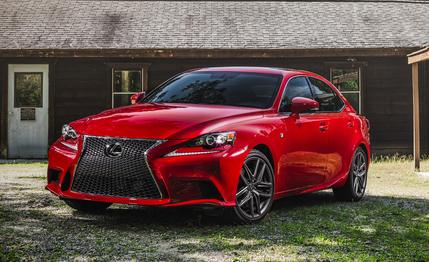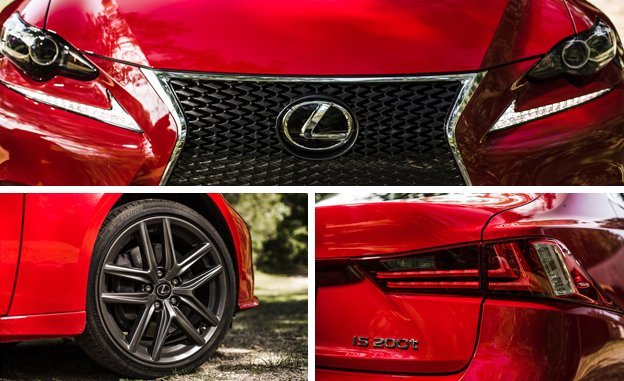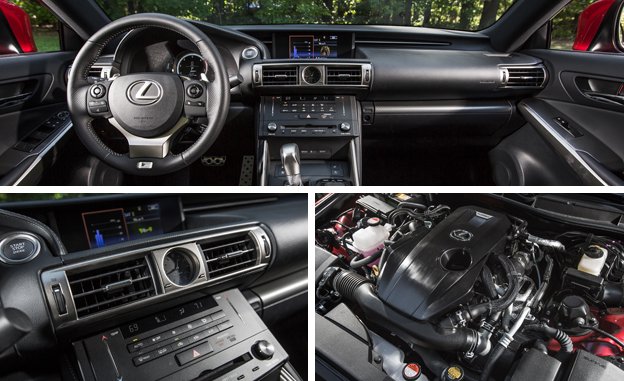
 Instrumented Test
Instrumented Test
Our world shifted a little on its axis when the then-new 2014 Lexus IS350 F Sport bested a BMW 3-series and a Cadillac ATS in a three-way comparison test. Could it be that Toyota’s serene luxury brand had, finally, fully embraced the sports-sedan ethos? Perhaps not, as subsequent tests of other IS variants left us less than thrilled. We were particularly disappointed by the 2014 IS250 in all-wheel-drive form, despite its F Sport chassis tuning.
For 2016, Lexus fixes its junior-grade sedan’s powertrain deficiencies by replacing the small-displacement V-6 that made a meager 204 horsepower and a weak 185 lb-ft of torque. Rear-drive models get the new 2.0-liter turbocharged four-cylinder tested here. Retuned for this application after first appearing in the NX compact crossover, it makes 241 horsepower and 258 lb-ft of torque in the sedan and mates to an eight-speed automatic. Those who simply must have power directed to all four wheels will get a larger, stronger 3.0-liter V-6 to offset the weight and friction penalties in that setup, but they must settle for only six forward gears in their automatic. Lexus still doesn’t see fit to offer a manual transmission in any IS sedan, which probably makes not one whit of difference in sales but does speak to priorities—Audi, Cadillac, and BMW still include shift-for-yourself transmissions in this class and Jaguar promises its XE range will offer one.


If any IS would benefit from a manual, it’s this 200t F Sport. The chassis tuning bears comparison with class leaders, with a stiff platform that delivers crisp turn-in and nice heft and feel in the steering. This car matched the 0.85-g skidpad rating we recorded for the comparison-test IS350. The brake pedal can feel lazy around town but firms up nicely when the driver makes real demands. It delivers consistent, fade-free stops from 70 mph in 171 feet. And the cabin says “driver’s car” from its LFA-influenced instrument panel to the supportive sport seats. What’s missing is a fully engaging personality.
That’s partly down to the new engine—turbocharged, 2.0-liter, direct-injected, DOHC, 16-valve four-cylinders have become ubiquitous, and the differences among them are better called subtle nuances than character traits. Lexus’s fulfills its mission at the track, getting a somewhat heavy sedan to 60 mph a full second quicker than the IS250 AWD could manage. The 15.3-second quarter-mile run was 0.8 second quicker and 100 mph came up 2.7 seconds sooner. It’s also a lot quieter at wide-open throttle; the 2.0-liter model doesn’t come with the in-cabin engine-noise “sound generator” that the F Sport V-6s get as standard equipment. The dealer-accessory catalog includes a “performance exhaust” for those who’d like more auditory feedback when approaching redline.
Speaking of which, the manual-mode shift paddles should offer a crisper response and more tactile rewards than they do; they’re also the only way to spin the tach all the way out to the fuel cutoff—left to its own devices, the eight-speed upshifts at 5800 rpm. Here again, a stick would work wonders.
All the numbers are respectable for this class. None is outstanding, though, and the leveling effect of this new industry norm extends to performance. Compare the IS250’s track numbers with cars as mainstream as the 2.0-liter turbo Kia Optima we recently tested and there’s little difference, right down to identical 22-mpg observed fuel economy. Rear-drive balance and driving feel differ, of course, and we prefer it in cars that handle this well. Cadillac squeezes more from its four in the ATS, which is rated at 272 horsepower; we’ve tested it only with a stick (as a coupe and as a sedan), and it was not just quicker but more entertaining to drive.
The 22 mpg we recorded with this Lexus is the same as we saw in the old IS250 AWD, despite the improved performance. Better, from Lexus’s standpoint, is that the EPA ratings of 22/33 mpg city/highway climb by 1 and 3 mpg. (The IS300 AWD version rates lower in each measure by 1 mpg versus the old IS250). Note that if you want the engine to deliver peak power, you’ll be pumping premium fuel.


Choose the F Sport trimmings and the base price rises $3545 over the regular IS200t’s $38,265. Our test car had the navigation package that includes an upgraded audio system ($2645), safety technology including blind-spot monitoring with cross-traffic alert ($600), and a heated steering wheel ($150). All of those options are called out on the consumer website configurator as “required” when ordering an F Sport—so the upcharge over a base car works out to considerably more than $3545. Our calculator says the all-in total is $45,205 and that should be called the base price, since it includes no genuinely optional options or accessories. Mercifully, Lexus’s list of add-ons is short and direct compared with those of its European competition. Still, the oxymoronic “required option” seems to exist only to befuddle those hoping to order a car equipped exactly to their own tastes.
For the price, the IS200t is a stylish (assuming you’re down with that grille), luxurious, and comfortable ride that doesn’t fall down on entertaining roads. Lexus has yet to truly deliver on the promise made by the excellent IS350 F Sport that is built on this chassis, but at least the junior model isn’t bog-slow anymore.